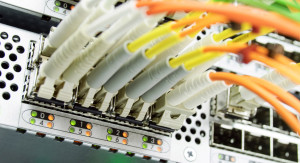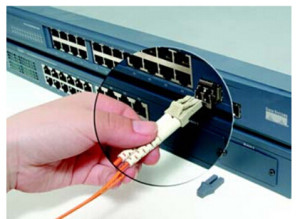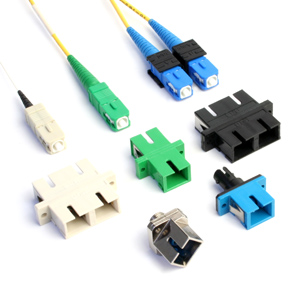 LC connector is a small form-factor (SFF) fiber optic connector. It uses a 1.25 mm ferrule, half the size of the ST. Otherwise, it is a standard ceramic ferrule connector. The LC has good performance and is highly favored for small form factor, high-density fiber optic connectivity with simplex, duplex, single-mode and multi-mode options. It has been gaining the preference of equipment manufacturers because of its compact size and performance.
LC connector is a small form-factor (SFF) fiber optic connector. It uses a 1.25 mm ferrule, half the size of the ST. Otherwise, it is a standard ceramic ferrule connector. The LC has good performance and is highly favored for small form factor, high-density fiber optic connectivity with simplex, duplex, single-mode and multi-mode options. It has been gaining the preference of equipment manufacturers because of its compact size and performance.
The LC connector system, standardized as TIA/EIA FOCIS-10, was designed specifically to address the needs of increasing network interconnect density. In the past, fiber management systems (for D4, ST, FC and Biconic), have required twice as many individual connectors as copper systems, hence, crowding racks and closets with additional patch bays, management hardware and line terminating electronics. SFF connectors have either a unitary body design (FJ and MT-RJ) or a provision for clipping simplex connectors together to form a single SFF end (LC). The LC connector provides the potential for twice the interconnect density in closets and racks when compared to a SC connector. Although, there is a point at which additional density cannot be utilized because of the difficulty in fiber routing inordinately large cable counts. Also at issue in these higher density racks, is the problem of disturbing adjacent circuits in MACs. Most important in fiber management, is the decreased footprint of the LC on electronics (hubs, switches, etc.) for fiber transceivers.
 In the emerging SFF connector landscape, the LC connector is clearly the leader in performance as well as installed base. Since the LC connector has been licensed widely and is now offered by most major cabling system vendors (including some early proponents of MT-RJ), the exact number of LC connectors shipped is difficult to ascertain. However, at least one vendor has shipped over 24 million LC connectors, with a mix of approximately 60% multi-mode and 40% single-mode. The MT-RJ connector places a distant second in both performance and installed base. The multi-mode version has found some support with a few large transceiver vendors and LAN equipment manufacturers, particularly for the less demanding 100BASE-FX interfaces. However, the LC connector is quickly becoming the preferred transceiver connector for high bit rate applications (1 Gb/s and above) due to its numerous advantages for transceiver design. More transceiver manufacturers support the LC interface than any other SFF connector, and LC transceivers are available from numerous sources for applications ranging from 10 Mb/s to 10 Gb/s.
In the emerging SFF connector landscape, the LC connector is clearly the leader in performance as well as installed base. Since the LC connector has been licensed widely and is now offered by most major cabling system vendors (including some early proponents of MT-RJ), the exact number of LC connectors shipped is difficult to ascertain. However, at least one vendor has shipped over 24 million LC connectors, with a mix of approximately 60% multi-mode and 40% single-mode. The MT-RJ connector places a distant second in both performance and installed base. The multi-mode version has found some support with a few large transceiver vendors and LAN equipment manufacturers, particularly for the less demanding 100BASE-FX interfaces. However, the LC connector is quickly becoming the preferred transceiver connector for high bit rate applications (1 Gb/s and above) due to its numerous advantages for transceiver design. More transceiver manufacturers support the LC interface than any other SFF connector, and LC transceivers are available from numerous sources for applications ranging from 10 Mb/s to 10 Gb/s.
The specific characteristics of the LC connector, including wide fiber spacing, better fiber alignment, precision mating, ease of connector cleaning, and simplex/duplex configuration, combine to produce overall superior performance for both factory-terminated and field installed connectors. This is apparent that the LC connector is the best choice for a cabling infrastructure. Meanwhile, for fiber management and transceivers, there is no doubt that LC connector is an ideal solution.
 Fiber optic connectors enables quicker connection and disconnection than fiber splicing. They are generally used to terminate the end of an optical fiber, e.g. fiber optic patch cables, or pigtails. But the common
Fiber optic connectors enables quicker connection and disconnection than fiber splicing. They are generally used to terminate the end of an optical fiber, e.g. fiber optic patch cables, or pigtails. But the common  Fiberstore supplies high-quality fiber optic connectors and adapters with a low price. Additionally, pre-assembly products, such as fiber patch cables and optical pigtails are also available with a short delivery time. Furthermore, we offer other ancillary products, e.g. FAPs, fiber optic wall plates, etc. For more information, please visit
Fiberstore supplies high-quality fiber optic connectors and adapters with a low price. Additionally, pre-assembly products, such as fiber patch cables and optical pigtails are also available with a short delivery time. Furthermore, we offer other ancillary products, e.g. FAPs, fiber optic wall plates, etc. For more information, please visit